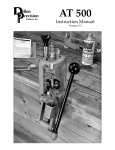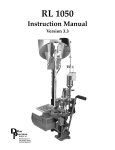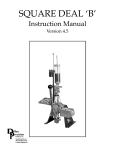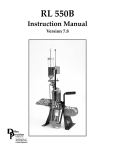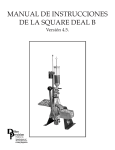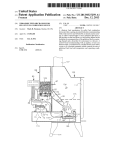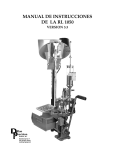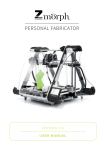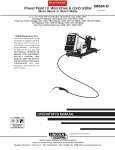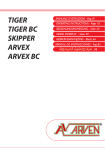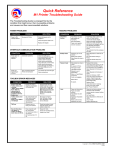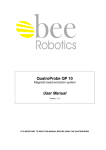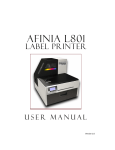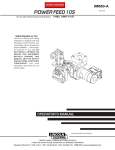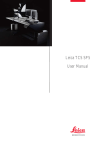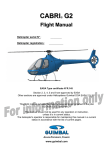Download 17153 - SL 900 Manual V2.9
Transcript
SL 900 Instruction Manual Version 2.9 illon recision Products, Inc. Manufacturers of The World’s Finest Loading Equipment On the cover… The SL 900 is pictured with optional accessories: Low Powder Sensor #16306 Aluminum Roller Handle #17950 Other accessories available for the SL 900 include: 20 gauge conversion #22138 28 gauge conversion #22139 20/28 casefeed plate #97045 Machine Cover #13329 The Blue Press, Dillon’s monthly catalog, has a complete listing of accessories available for all machines. Dillon Precision Products, Inc. 8009 E. Dillon’s Way Scottsdale, AZ 85260 (480) 948-8009 FAX (480) 998-2786 Web Site: www.dillonprecision.com E-mail: [email protected] Technical Support & Customer Service (800) 223-4570 Part #17153 Spot Manuals SL 900 Manual Folder SL 900 Manual.V2.9 10/01 WJC TABLE OF CONTENTS Parts List, Schematics and Diagrams SL 900 Machine Mounting Assembly Upper Machine Assembly Shot Container Assembly Casefeeder Assembly & Parts List Casefeeder Bowl Mount & Casefeed Assembly to Frame Lower Machine Assembly Toolhead Assembly Platform Assembly Primerfeed Assembly & Installation Automatic Powder Measure Assembly Shot Dispenser Assembly Wad Swing Arm Assembly Finished Shotshell Dimensions General Machine Information Step-by-Step Preliminary Assembly Factory Settings Filling the Machine with Components – What’s First? Let’s Begin Making a Few Rounds Changes and Adjustments Adjusting the Collet Sizer Powder Die/Funnel Adjustments Adjusting the Automatic Powder System, Powder Charge Weight Adjusting the Wad and Shot Station Adjusting the Starter Crimp Die Removing the Shot From the Machine Removing the Toolhead Shellplate Removal Switching to Another Powder The Primer System Gauge Conversion - 28 ga. Gauge Conversion - 20 ga. Troubleshooting Section Primer System Casefeeder General Lube Points Suggested Settings 5 - 17 6 7 8 9 10 11 12 13 14 15 16 17 17 18 - 19 19 - 23 24 - 25 26 - 29 29 - 31 31 - 37 31 32 32 32 - 33 33 33 - 34 34 - 35 35 - 36 36 37 38 - 42 43 - 47 48 - 49 48 48 - 49 49 50 51 SL 900 Parts List Part # 10716 12577 13311 13418 13485 13613 13667 13677 13700 13701 13738 13742 13773 13789 13791 13793 13799 13801 13830 13837 13840 13841 13848 13856 13858 13871 13891 13895 13896 13911 13923 13937 13938 13943 13958 13966 13988 13989 13996 14008 14013 14023 14026 14037 14041 14118 14574 14689 14808 14922 16065 16209 16221 16222 16340 16667 16668 16670 16671 16672 Description Primer Spring Cap 1/2-20 Jam Nut Spring Pin Shellplate Bolt Mainshaft Clamp Index Pawl Ring Indexer Link Arm Shoulder Pin 3/32x3/8 Dowel Pin 10 Stainless Washers 1/2 E-Clip 8-32 Nut 1/4-28 Set Screw Indexer Return Spring Collar Roller Blue Wing Nut Tinnerman Nut Mainshaft Pivot Pin 1/4 E-Clip Hitch Pin Clip Nylock Nuts Bellcrank Bushing 1/4 Washer SAE Rod Compression Spring Bellcrank Cube 3/8 Index Ball 10-24x3/8 BHCS 1/4-20 x 3/8 BHCS 1/4-20 x 2 3/4 Bolts 1/4-28 Brass Tip Set Screw Slide Return Spring Pawl Spring 1/4-28 Adjustment Bolt 1/4 Washer 1/4-28 x 3/4 SHCS 1/4-20 Nuts 10-24 x 5/8 SHCS 10-32 Set Screw Toolhead Pins 8-32x3/8 SHCS 8-32 x 3/4 BHCS 8-32 x 1/2 BHCS 10-24 x 3/4 SHCS 1/4 Wave Washer Index Ball Spring Case Insert Slide Spring Cap 8-32 x 1/4 BHCS Collar Roller Bushing Link Arms 650 Machine Mounts Spent Primer Cup Bracket 1/4 Fender Washer 1/4-20 x 11/2 Hex Bolts 10-32 Nylock Nut Toolhead Toolhead Die Lockplate SL Crank Indexing Block Shotshell Chute Part # 16675 16676 16677 16678 16679 16680 16681 16682 16683 16684 16691 16692 16693 16694 16695 16696 16697 16698 16699 16700 16701 16702 16705 16707 16708 16709 16710 16711 16713 16714 16717 16721 16723 16724 16725 16726 16727 16731 16732 16733 16734 16735 16736 16737 16738 16739 16740 16741 16742 16743 16744 16746 16747 16748 16750 16751 16752 16753 16904 17123 Description Shellplate, 12 ga. Ejector Wire Wad Swing Arm Wad Guide Sleeve Sleeve Compression Spring 1/16 x 1/2 Roll Pin Wad Guide Swing Arm Torsion Spring Case Insert Slide Slide Block Primer Transfer Arm Arm Pivot Pin Transfer Arm Spring Station Two Locator Locator Pivot Screw Locator Torsion Spring Case Insert Ramp SL Platform Spent Primer Cup Primer Seater Pin Bushing Primer Seater Spring SL Casefeed Tube Phish Compression Spring Casefeed Phish Camming Pin Clear Primer Tray Cover Primer Feedplate SL Primer Slide Upper Slide/Bellcrank Spring Primer Feed Cam Tray Mounting Bracket Primer Feed Body Shot Hopper Shot Dispenser Body Shot Drop Tube, 12 ga. Shot Dispenser Bellcrank Spring (Bellcrank Assembly) Pivot Pin Shot Bar Return Rod Rod Bushing Shot Body Collar Body Collar Adjustment Screw Collar Guide/Clamp Shot Bar Shot Bar Insert 3/8-16 Half Dog Set Screw Depriming Pin SL Sizer Collet Sleeve Collet Sizer Die, 12 Ga. SL Powder Die Expander Powder Funnel Starter Crimp Die Dillon Starter Crimp Insert-1 Final Taper Crimp Die, 12 Ga. Final Seat Plug, Rem. 12 Ga. 5/8-18 Jam Nut Locator Buttons 1 1/2-10/32 SHCS SL 900 Casefeed Post 5 Part # 17124 17125 17126 17130 17131 17132 17134 17138 17139 17140 17141 17142 17143 17146 17147 17148 17149 17153 17182 17202 17350 17351 17352 17353 17354 17472 17474 17476 17477 17479 17509 17573 17601 17603 17604 17637 17639 17812 17836 17837 17838 17839 17843 17899 17909 20782 22134 22183 97037 97120 N/A N/A N/A N/A N/A N/A N/A Description Shot Post Dillon Bin Locator Button Spring Casefeed Sleeve, 12 Ga. Casefeed Body Primer Drop Tube Primer Bellcrank Clear Hopper Lid Shot Dispenser Fitting Pin (Bellcrank Assembly) 1/4 Hardened Washer Dispenser Top Dispenser Top Clear Lens Rubber Insert Powder Die E-Clip 1 1/4 Die Lock Ring 1.0 Die Lock Ring Manual SL Frame Machined Shot Fitting E-Clip Powder Bar Return Rod Die Lock Bolt Spring Button Phish Spring Socket Gate 3 #8 Washer .032 Thick 10-32 x 5/8 Tray Cover Screw Shot Drain Collet Sizer Spring Clear Industrial Vinyl Tubing Box Shot Drain Ext. Spring Washer .100 Thick Black Knob Clevis Pin 1/4-20 x 4 1/2 Hex Head Screw .175 dia. x 1/4-20 Post Primer Seater Assembly Final Seat Plug, A-A 12 Ga. Tyton Clamp P/M Lock Link P/M Slotted Bellcrank SL 900 Foam Insert Set Stem Screw Eight Star Crimp Dillon Powder Measure Shot Dispenser Assy - 12 ga. Roller Handle Assembly 12 Ga. Casefeeder – 110v Red Flag Lock Link Lock Link Torsion Spring Pivot Pin Return Spring Pin Shot Bellcrank Rivet SL Bellcrank Stud Spare Parts Bag SL 900 Mounting Assembly 16222 (4) 13856 (4) 13988 (4) 16065 (2) 16672 13911 (4) 13856 (4) 16221 (4) 17125 13988(4) 6 Upper Machine Assembly 17123 16676 17124 13418 16675 13966 13988 13667 13791 13613 13938 13677 16699 13613 13856 13988 17637 13613 13989 13989 17637 13856 7 Shot Container Assembly 16724 17202 17139 17478 17202 17478 17479 17139 ;; 8 ;; Casefeeder Assembly Casefeeder Assembly Parts List 13813 13732 (4) 13632 13738 (2) 17133 13400 17587 17507 13736 14026 (5) 14038 13779 17587 (3) 16704 13954 13473 13540 13912 16334 17586 14137 13539 9 Part # 13400 13473 13539 13540 13632 13685 13732 13736 13738 13779 13813 13833 13903 13912 13954 14025 14026 14038 14137 16314 16334 16336 16337 16704 17133 17585 17586 17587 17808 97037 Description Casefeed Bowl Casefeed Motor - 4 RPM Casefeed Cord Set Casefeed Motor Cover Casefeed Upper Disc Clutch 1/4-20x5/8 BHCS 10-32x1.00 SHCS Clutch SS Washers Micro Switch Lockwashers 1/4 Terminal Connector 1/4-20 Heli Coil 8-32 Flat Head Screw 4-40 Screws 1/8x3/4 Roll Pin Bowl/Motor Screws 40-40 Nuts 8x1 Cover Screw Zn. Butt. Connector Lighted Rocker Switch Red 1/4 female Insulated Connector Blue 1/4 female Insulated Connector Shotshell Funnel Shotshell Disc Zener Diode 1N5361B 8x1 1/4 Funnel Screw 8x1/4 PHL. PN. Screws Casefeed Bowl Insert 12 ga. Casefeed Assembly – 110v Casefeeder Bowl Mount Casefeed Assembly to Frame 16707 17353 16708 16680 17130 13685 16680 17131 17472 16705 14026 17123 14689 13989 (3) 17124 16709 10 Lower Machine Assembly 17182 16671 13989 17637 13841 13700 14922 13830 13485 13841 22183 Handle Assembly 14922 13789 16670 13841 11 Toolhead Assembly 20782 16752 16750 16751 Remington 13989 Seat Plug Guide 16751 (black) 17836 (silver) Remington only A-A and Federal 17147 17836 A-A 12577 16668 16747 16744 17149 16667 17148 16746 17141 17149 13896 13742 17899 17351 16743 17909 14008 ;; ;; 13895 16742 16748 ;; ;; 17477 16741 12 Platform Assembly 16695 16684 16696 16694 16683 14574 13891 16753 (3) 17126 (3) 14118 13937 13738 16697 14037 17944 13789 16692 17472 17639 16691 16700 16693 14689 14689 16701 16209 17812 assembly 16702 16699 10716 13837 13 13311 Primer Feed System Assembly & Installation 16713 14026 16721 16717 13923 17354 17134 16723 17603 (3) 13856 17601 16714 13793 17474 (3) 14808 14023 16340 17132 16710 14026 ;;; ;;; ;;; ;;; ;;; ;;; 17472 16711 14026 17472 ;;; ; ;;;;;;;;;; ;;;;;; 17472 13773 17472 13773 14 Automatic Powder Measure Assembly 13882 17140 17838 13691 13893 16732 17839 13943 13853 14041 16731 13958 13652 13871 13921 17839 14202 13848 16904 22273 14202 Part # 13652 13691 13793 13799 13801 13845 13848 13853 13858 13871 13882 13893 13921 13939 13940 13943 13958 14023 14037 14041 14202 14808 16340 16731 16732 16734 16904 17140 17350 17838 17839 20063 22273 Description 16340 Powder Bar Part, Large Powder Measure Tube Only Roller Blue Wing Nut Tinnerman Nut Collar Sleeve Bellcrank Bushing Powder Bar Insert, Large Rod Compression Spring Bellcrank Cube 13939 Powder Measure Lid Powder Bar Post, Large Powder Measure Plug Body Collar Clamp Connector Body Collar Powder Bar Bolt 14037 Powder Bar Bolt Washer 8-32 x 3/4 BHCS 10-24 x 3/4 SHCS (2) Bowed Washer Powder Measure Tube Screws Collar Roller Bushing Nylon Lock Nut Spring Pivot Pin Rod Bushing 10-32x1 1/2 SHCS Pin Powder Bar Return Rod P/M Lock Link P/M Slotted Bellcrank Powder Bar Assembly, Large Powder Dispenser Body 14041 17350 13940 13793 14808 14023 13845 16734 13858 13799 15 13801 Shot Dispenser Assembly - # 22134, 12 gauge shown 17138 17202 17143 17139 17142 17573 13701 14026 17476 14013 17146 16725 13996 13871 13817 16727 16739 16740 13958 14041 13848 14041 16738 13793 16904 14808 16726 13738 16733 14023 16740 16735 16737 16736 16734 13858 13989 13799 13801 16 13943 Wad Swing Arm Assembly Finished Shotshell Dimensions 12 gauge shown Here are some dimensions of a typical 12ga. shotshell. Always use a quality dial caliper when measuring your shotshells. Length may vary dependent upon shotshell manufacturer. Dimensions shown are for maximum, uncrimped overall length. If you find it necessary to adjust the collet size die, try to shoot for a middle of the road measure of the brass base. 2.76 -.100 17352 16681 16679 .800-.809 Dia. typical base diameter 16678 NOTE: Periodically lube this sleeve with light oil. 16680 Wad Seated Depth Wad & Shot Approx. Depth When developing loads for 7/8 - 1 oz. 1.12 - 1.20 shotshells be aware of your “wad 1 1/8 oz. 1.30 - 1.35 seated depth.” Here’s a reference 1 1/4 oz. 1.45 - 1.50 guide for the popular wad and shot weight used presently. Example, if your loads currently use a wad for 1 1/8 oz. of shot and you decide to reduce your shot weight and switch to 7/8 of an ounce wads, readjust the shot dispenser tube via the body collar adjustment screw. Clockwise rotation raises the shot dispenser tube and decreases the depth the wad is seated into the shotshell. Counterclockwise rotation lowers the shot dispenser tube and the wad will get seated deeper into the shotshell. 16677 13840 16682 17604 Finished Round Information Your loaded round length will vary due to loads used, type of wads, and brand of shotshells. We found that a majority of the Winchester ammo loaded fell toward 2.30 - 2.325 length. The Remington and Federal ammo loaded measured 2.33 2.350 overall length. Always use a reputable loading manual when reloading shotshells. 13789 17 seated depth .065 2.30 2.350 overall length MANDATORY SAFETY MEASURES Reloading ammunition and handling powder and primers is inherently dangerous. Just as in shooting, accidents do happen. These accidents are nondiscriminatory; they happen to both the novice and the experienced reloader. We have done everything we know how to make your machine as safe as possible. We cannot, however, guarantee your complete safety. To minimize your risk, use common sense when reloading and follow these basic rules: Never operate the machine without ear and eye protection on. Call our customer service department at (800) 223-4570 for information on the wide variety of shooting/safety glasses and hearing protection that Dillon has to offer. • PAY ATTENTION: Load only when you can give your complete attention to the loading process. Don’t watch television or try to carry on a conversation and load at the same time. Watch the automatic systems operate and make sure they are functioning properly. If you are interrupted or must leave and come back to your loading, always inspect the hulls at every station to insure that the proper operations have been completed. • SMOKING: Do not smoke while reloading or allow anyone else to smoke in your reloading area. Do not allow open flames in reloading area. • SAFETY DEVICES: Do not remove any safety devices from your machine or modify your machine in any way. • LEAD WARNING: Be sure to have proper ventilation while handling lead components or when shooting lead bullets. Lead is known to cause birth defects, other reproductive harm and cancer. Wash your hands thoroughly after handling anything made of lead. • LOADS AND LENGTHS: Avoid maximum loads and pressures at all times. Use only recommended loads from manuals and information supplied by reliable component manufacturers and suppliers. Since Dillon Precision has no control over the components which may be used on their equipment, no responsibility is implied or assumed for results obtained through the use of any such components. Refer to a reliable loading manual for overall length (OAL). • QUALITY CHECKS: Every 50-100 rounds, perform periodic quality control checks on the ammunition being produced. Check the amount of powder being dropped and primer supply. • RELOADING AREA: Keep your components safely stored. Clear your work area of loose powder, primers and other flammables before loading. • COMPONENTS: Never have more than one type of powder in your reloading area at a time. The risk of a mix-up is too great. Keep powder containers closed. Be sure to inspect hulls prior to reloading for flaws, cracks, splits or defects. Throw these hulls away. Keep components and ammunition out of reach of children. • WINCHESTER HULLS: Please be aware that Winchester has redesigned the AA target hull. This hull is no longer a one-piece extruded design. Now, it is a two-piece hull incorporating an inner reinforcing tube which extends partway up the interior of the hull. Winchester wads have been redesigned to work with this new design. Additionally, some aftermarket wads are now available which are compatible with the redesigned hulls. Other wads may not be compatible with the new AA hulls. We suggest that you visually inspect your hulls, and load the old and new style hulls separately, using components appropriate to each style of hull. • BLACK POWDER: Do not use black powder or black powder substitutes in any Dillon powder measure. Loading black powder cartridges requires specialized loading equipment and techniques. Failure to do so can result in severe injury or death. • PRIMERS: Never force primers. If they get stuck in the operation of the machine, disassemble it and gently remove the obstruction. Never attempt to deprime live primers – eventually one will go off. When it does it will detonate the others in the spent primer cup. Depriming live primers is the single most dangerous thing you can do in reloading and can cause grave injury or death. • LOADED AMMUNITION: Properly label all of your loaded ammunition (Date, Type of wad, primer, powder, shot charge, etc.). • BE PATIENT: Our loading equipment is conservatively rated and you should have no trouble achieving the published rates with a smooth, steady hand. If something doesn’t seem right, stop, look and listen. If the problem or the solution isn’t obvious, call us. The reloading bench is no place to get into a hurry. • REMEMBER: If your machine does not perform to your expectations, or if you are having technical difficulties, give us a call: (800) 223-4570 GENERAL MACHINE INFORMATION Based on our XL 650 machine frame, the SL 900 comes to you with some great automated features. Starting from the right rear of the machine, the SL 900 features an electric casefeeder. This unit holds approximately 80 empty hulls; enough for three boxes of shotshells. Turn the electric casefeeder on and the shotshell disc (#17133) will rotate until the feed tube has filled, then the microswitch will shut the unit off. Every stroke of the roller handle (#22183) transfers one empty hull from the feed tube to the shellplate via the case insert slide ramp. Once a hull has been placed in station one of the machine, moving the roller handle (#22183) down will resize the brass base of the hull, expand the mouth of the hull and remove the old primer. NOTE: Always examine the hulls for rocks, dirt, mud or other cases that may get stuck inside. Also look for hulls that may appear stepped on or flattened. Go ahead and squeeze them 18 E. A. M. J. H. F. K. G. N. B. I. C. L. D. Fig. 1 - A.) Dillon Bin B.) Shotshell Chute C.) Strong Mounts D.) Universal Mounting Kit and Hardware needed for Strong Mount installation E.) Shot Container and Post F.) Shot Dispenser Hardware G.) Shot Bar Return Rod and Powder Bar Return Rod H.) SL 900 Toolhead and Frame I.) Spent Primer Cup J.) powder measure K.) Roller Handle L.) Hardware for Shot Post and Casefeed Post Assembly M.) Casefeed Bowl and Post N.) Clear Casefeed Tube round again so they won’t get stuck in the casefeed tube (#16705). Returning the roller handle (#22183) to its full aft position will advance the hull to station two, where a new primer is inserted into the hull when you push the roller handle (#22183) aft. The automatic primer system holds 100 shotshell primers. Every complete stroke of the roller handle (#22183) will feed a primer to the hull. The automatic powder system is also located at station two. The hopper holds one half pound of powder and has a fully adjustable powder bar. The automatic powder system is hull activated. Move the roller handle (#22183) down. When the hull contacts the expander/powder funnel (#16746), the powder measure is pushed up, causing the powder bar to move and dispense one charge of powder into the hull. Raise the roller handle (#22183) to its rest position. The powder bar will recharge and the hull will advance to station three. At the third station (left, front of the machine) we will insert the wad and meter the shot into the shell. Move the roller handle (#22183) aft as if you are seating a primer into the hull. You will see the wad swing arm (#16677) tilt out, ready to accept a new wad. With every complete stroke of the roller handle (#22183), insert a new wad into the wad swing arm (#16677) when it tilts out. Move the roller handle (#22183) down. The shot drop tube (#16726) inserts the new wad into the empty hull and will dispense shot into the hull. Raise the roller handle (#22183) and push aft to prime. Hold the handle aft while you insert a wad into the swing arm. At station four we start the crimp in the top of the loaded hull. It is formed and folded closed, preparing the hull for the final crimp and seating performed in station five. The formed, folded top of the hull will now be crimped and seated closed. This die is fully adjustable. The crimp and seating depth can be adjusted to the desired settings. This die also has a taper crimp feature inside that will form a tapered end to the hull. Again, move the roller handle (#22183) down and then back up to its rest position. The completed shotshell advances out of the machine, down the shotshell chute (#16672) and into the Dillon bin (#17125). Fig. 2 STEP BY STEP PRELIMINARY ASSEMBLY 1. Fasten the strong mounts (#16065) to the base of the machine while it is lying on its side. Fig. 2 19 Fig. 3 Fig. 6 Microswitch 2. Lift the machine up and fasten the machine securely to the forward edge of the bench. Fig. 3 Fig. 4 5. Open the casefeeder box. Place the feeder on your bench and plug it into a 110v AC outlet (220v for European casefeeders). Place a handful of empty hulls into the casefeeder (approximately 10). Turn the unit on and familiarize yourself with its operation. Notice how every time an empty hull exits the casefeeder, it passes a microswitch. Later in the loading process, you will see that every time the hull is next to the microswitch the motor will shut off. Fig. 6 Fig. 7 3. Install the casefeed post (#17123) and the shot post (#17124) to the frame of the machine using the two long 4 1/2" bolts, 6 clamps (#13613), 2 - 1/4" washers and 1/4-20 nuts. Fig. 4 Fig. 5 4. Locate the shot container and place it on its post. Fig. 5 6. Place the casefeeder on its post. Find the clear feed tube and place the bottom of the tube into the 12 Ga. casefeed sleeve (#17130). Align the casefeeder on the post with the clear feed tube and snap the feed tube into its receiver. Snug the 1/420 screw on the rear of the casefeeder to secure the position of the casefeeder. Please do not fill the clear feed tube with empty hulls. This step will be completed later. Fig. 7 20 Fig. 8 Fig. 10 13685 Be sure to secure the small, but important, screw located at the rear of the bowl at the base. This little screw (#13685) secures the entire bowl assembly to the casefeed post (17123). Fig. 8 Fig. 9 #13921 8. Remove the blue cap on the powder die (#16744). Loosen the two Allen screws and place the powder measure (#20782) on the powder die (#16744). The clamp must lock into the groove of the die, then secure the two Allen screws firmly. Fig. 10 Fig. 11 7. The powder measure (#20782) is the next item we’ll be installing on the machine. Familiarize yourself with its operation – every complete stroke of the powder bar dispenses one charge of powder. The dispenser is hull activated. Using a 7/16” wrench, rotate the bolt located on the end of the powder bar – counterclockwise will reduce the powder charge weight, clockwise will increase the powder charge weight. Fig. 9 Be sure to install the powder measure plug (#13921) here – see arrow Fig. 9. 9. Locate the parts bag for your machine. Enclosed is a powder bar return rod (#17350) Fig. 11. The powder bar return rod (#17350) must be inserted into the bellcrank from its left side. On the bottom of the rod is a blue wing nut (#13799), spring and white rod bushing (#16734). Slide this end into the receiver (see arrow Fig. 11) and snap 21 the rod bushing (#16734) into the platform. Thread the blue wing nut (#13799) “up” until there’s some spring tension against the platform – two to three turns. Do not fill the powder measure (#20782) at this time. This will be completed later. Fig. 14 Fig. 12 Fig. 15 10. Next we move to station three where the wad is seated and the shot is dispensed. The Dillon shot dispenser works similar to the powder measure (#20782). The shot dispenser is activated by the hull at this station. No hull – no shot. Every complete stroke of the shot bar dispenses one charge of shot. To adjust, loosen the bolt set screw (#16740) 1/4 of a turn. Then use a 7/16” wrench to rotate the bolt located on the end of the shot bar (#16738) – counterclockwise will reduce the shot weight and clockwise will increase the shot weight. Fig. 12 12. Assemble the shot dispenser fittings to the clear shot feed tube. Fig. 14 Place the tube clamps loosely on the tube. Slide one end of the shot dispenser fitting into the bottom of the shot hopper (#16724 item A Fig. 13) and lock it in using one of the shot fitting e-clips. Now, align the complete assembly and install the other shot dispenser fitting and e-clip into the dispenser top (#17142) and tighten the clamps. Fig. 15 Fig. 13 A 11. To complete the assembly of the shot dispenser tube, you’ll need the following items from the parts bag: shot bar return rod (#16733), clear shot feed tube, two shot dispenser fittings (#17139), two shot fitting e-clips (#17202) and two tube clamps. Fig. 13 22 Fig. 18 Fig. 16 13. When installing the shot bar return rod (#16733), use your left hand to move the lock link down over the slot in the shot dispenser bellcrank. Fig. 16 Now, insert the hook end of the shot bar return rod (#16733) through both parts. On the bottom of the rod is a blue wing nut (#13799), spring and white rod bushing (#16734). Slide this end into the receiver and snap the rod bushing in the platform. Thread the blue wing nut (#13799) “up” until there is some spring tension against the platform – two to three turns. Do not fill the shot dispenser at this time. 15. Position the Dillon bin (#17125) on the machine’s right side, then place the shotshell chute (#16672) between the machine and the Dillon bin (#17125). Fig. 18 Fig. 19 Fig. 17 14. Place the spent primer cup (#16699) on its spent primer cup bracket (#16209), it’s located on the lower right hand side of the machine’s platform – slide the cup onto the bracket rails. Fig. 17 16. Finally, install the roller handle (#22183). Fig. 19 23 FACTORY SETTINGS The SL 900 shotshell machine has been assembled and tested using Winchester AA hulls. A sample is included with the machine. Fig. 21B Complete Stroke Fig. 21C Incomplete Stroke Fig. 20 Station One – The collet sizer is adjusted for resizing the brass base. Fig. 20 Fig. 21 The powder die has been adjusted to a height so that the powder measure bellcrank can make full strokes when activated. Fig 21B. Turning the powder die (#16744) counterclockwise will raise the powder system, reducing the amount of stroke the bellcrank has. Fig 21C. Fig. 22 Station Two – Inside the powder die (#16744) you’ll find the powder funnel Fig 21. This part uniforms the top of the shotshell hull and dispenses one charge of powder into the hull. The powder bar will need to be adjusted to the desired powder weight. Its important to use a quality powder scale to do this. Fig 21A Fig. 21A Station Three – Two operations occur here involving wad and shot insertion. In the wad swing arm (#16677) we’ve installed a caliber specific wad guide (#16681). Fig. 22 24 Fig. 23C Fig. 23A Incomplete Stroke Turning the body collar adjustment screw (#16736) clockwise (too high) will raise the shot dispenser, reducing the amount the wad is seated into the hull and may result in an incomplete stroke of the bellcrank. Fig 23C Fig. 24 16739 16740 Remember: Loosen the bolt set screw before making any adjustments. 13943 16738 13958 14041 The shot bar has a preliminary setting for 1 1/8 oz shot weight. The shot bar will need to be adjusted to your desired weight. Fig 23A Fig. 23B Complete Stroke Station Four – The starter crimp die (#16747) forms and folds the loaded shotshell hull. This die is set for Winchester AA hulls so we achieve 60% closure of the top. Fig. 24 Fig. 25 The body collar adjustment screw (#16736) has been adjusted to seat the 1 1/8 oz (WAA-12) plastic wad into the hull. The shot dispenser bellcrank makes a complete stroke and dispenses one charge of shot wile the wad is being seated into the hull. Fig 23B Station Five – Here we’ll finish crimp and seat. A final seat plug (#16751) presses the hull back down and below the top by approximately 1/16 of an inch. The taper crimp feature within the die radiuses and blends the end of the hull and locks the crimp on the hull. It too is adjusted for Winchester AA hulls. Fig. 25 25 FILLING THE MACHINE WITH COMPONENTS. WHAT’S FIRST? Before you charge ahead and begin tossing components into your new SL 900 shotshell machine, there is a routine we’d like you to follow. Fig. 26 Fig. 27 Fig. 28 D-Terminator Electronic Scale #13681 (pictured) Eliminator Beam Scale #13480 1. Fill the powder hopper with the powder of your choice. Fig. 26 2. You will need a once-fired shotshell with a spent primer. Fig. 27 3. You will need a powder scale to weigh the powder charges. Fig. 28 then back to its rest position. Remove the hull from the shellplate by pressing down on the locator button (#16753) and pour the powder back into the clear powder hopper. Fig. 30 6. Repeat steps 4 and 5 a minimum of four times so you are receiving a uniform powder charge. 7. Weigh the fifth powder charge. Using a 7/16” wrench, rotate the bolt located on the end of the powder bar. Counterclockwise will reduce the powder charge weight. Clockwise will increase the powder charge weight. Adjust as needed. 8. Again, repeat steps 4 and 5 until you’re happy with the powder charge. Now that you have determined the powder charge, let’s go on to station three for wad and shot insertion. Let’s use the same hull, with powder, in station three. 1. Get a supply of wads. Fig. 31 Fig. 29 2. Move the roller handle (#22183) to its full aft stop position, away from you. Doing so will cause the wad swing arm (#16677) to pivot out so you can insert the wad. Fig. 31 Let the roller handle (#22183) return to its rest position. 4. Place the hull in station two where the powder measure (#20782) is located. Gently move the station two locator (#16694) away from the shellplate and insert the hull. Fig. 29 Fig. 32 Fig. 30 3. Remove the clear hopper lid (#17138) and add a small amount of shot to the shot dispenser. Fig. 32 5. Move the roller handle (#22183) down and 26 Fig. 33 Fig. 35 4. Move the roller handle (#22183) down and then back up to its rest position. Remove the hull from the machine by pressing down on the locator button (#16753) and pour the shot back into the shot dispenser. Fig. 33 2. Move the roller handle (#22183) down and then back to its rest position. The formed and folded hull has just completed station four and has advanced to station five. Fig. 35 Fig. 36 Fig. 34 5. Place the hull back into station three and again move the roller handle (#22183) down and then back to its rest position. Remove the hull and weigh the shot charge. Fig. 34 6. Loosen the bolt set screw (#16740) 1/4 of a turn. Then using a 7/16” wrench, rotate the bolt located on the end of the shot bar (#16738). Counterclock- wise turns will reduce the shot charge weight. Clockwise turns will increase the shot charge weight. Adjust as needed. NOTE: Its always easier to make adjustments when the bar is empty and in the forward drop position. 7. Again, repeat steps 4 and 5 until you’re happy with the shot charge. Remember to place the clear hopper lid (#17138) back onto the shot dispenser & tighten the bolt set screw (#16740). Now that you have determined the shot charge, let’s move on to station four and five where the starter crimp die (#16747) and final seat/crimp functions are performed. Let’s use the same hull (with shot). 1. Place the hull (with shot) into station four. 3. Once again, move the roller handle (#22183) down. As you return to the rest position, you’ll see the completed round advance and move out of the machine. The completed round will fall down the shotshell chute (#16672) and land in the Dillon bin (#17125). Fig. 36 Review the dummy round you’ve just made. Let’s go ahead and make one more dummy round. Please note, when making these dummy rounds, we start at station two and then go through all the remaining stations on the machine. This is the introductory process. Next we’ll be adding empty, fired hulls and new primers. 27 that the casefeed tube is fully seated into its clamp. 5. Get one box of new shotshell primers. Fig. 37 Fig. 40 1. Using a Dillon bin (#17125) or box, gather up to 80 empty, fired hulls. Fig. 37 Fig. 38 6. Slide the cardboard jacket back, exposing only half of the first row of primers. Fig. 40 7. Turn the box of primers over. Fig. 41 2. Always examine the hulls for rocks, dirt, mud or other cases that may get stuck inside. Also look for hulls that may appear stepped on or flattened. Go ahead and squeeze them round again so they won’t get stuck in the casefeed tube (#16705). Fig. 38 3. Pour the hulls into the casefeeder and turn the unit on. 8. Place the leading edge of the primer tray into the machine’s primer feedplate (#16711). Fig. 41 Fig. 42 Fig. 39 Microswitch 4. The casefeeder will run until the casefeed tube (#16705) has filled, then shuts off automatically when a hull trips the microswitch. Fig. 39 Insure 9. Slide the cardboard jacket off. Helpful hint – as you slide the cardboard jacket off, place your lefthand index finger on the primer tray and press down as you slide the jacket off. Fig. 42 28 Fig. 43 aft position. A hull has been fed into the shellplate. Fig. 45 Fig. 46 10. Lift the plastic primer tray straight off the primers. Do not rotate. Check that no primers have turned on their side. If so, straighten. Fig. 43 Fig. 44 2. Push the roller handle (#22183) aft, away from you. Doing so inserts the hull fully into the shellplate and the first primer appears at station two. Remove this primer and set it aside. Fig. 46 3. Move the roller handle (#22183) down. The first hull is being resized and the old primer has been removed from the hull. Fig. 47 11. Raise the primer gate and the group of primers will slide down to the primer slide upper (#16713). Fig. 44 Note that every complete stroke of the roller handle (#22183) will feed one primer into the machine while at the same time completing the other processes within the machine. LETS BEGIN MAKING A FEW ROUNDS If you’re like me, you have already figured out that when you cycle the roller handle (#22183), hulls feed into the shellplate and primers also feed into the machine. Let’s begin making a few rounds and I’ll explain the loading process, using the first hull as our guide. 4. Return the roller handle (#22183) to its rest position. The first hull advances to station two and another hull has been fed to the shellplate. Fig. 47 Fig. 48 Fig. 45 5. Push the roller handle (#22183) aft, away from you. Doing so seats the new primer into the first hull at station two, and another hull is fully seated into the shellplate at station one. To ensure that you have 1. With all the stations empty, move the roller fully seated the primer into the hull, it is important to handle (#22183) down and then back up to its full stroke the operating handle to its full aft position. 29 With experience, you will acquire the “feel” of the primer being seated fully. Fig. 48 6. Move the roller handle (#22183) down. The first hull is getting a charge of powder at station two. is seated. It then receives a charge of shot. Again, the hulls in station one and station two are being processed as well. Fig. 51 Fig. 52 Fig. 49 7. Return the roller handle (#22183) to its rest position. The first hull advances to station three, another fired hull is fed to the shellplate and the hull at station two is ready to receive a new primer. Fig. 49 Fig. 50 8. Push the roller handle (#22183) to its full aft stop and hold as (using your left hand) you pick up a plastic wad and place it into the wad guide (#16681). This same aft stroke seated the new primer into the hull at station two and the hull at station one is fully seated into the shellplate. Release the roller handle (#22183). Fig. 50 10. Raise the roller handle (#22183) to its full aft stop. The first hull advances to station four and the other hulls advance as well. Fig. 52 If you encounter resistance, STOP! Do not force the handle. There may be something blocking the primer transfer arm. See the troubleshooting section for instructions on how to proceed. 11. Push the roller handle (#22183) aft to seat the primer into the hull at station two and place a new plastic wad in the wad guide (#16681). Special note: An important step in the loading process – remember when pushing the roller handle (#22183) aft to seat the new shotshell primer, you must also place a new plastic wad into the wad guide (#16681) at the same time. See Fig. 50 12. Move the roller handle (#22183) down. The first hull is being formed and folded with the starter crimp die (#16747) at station four. Fig. 53 Fig. 51 9. Move the roller handle (#22183) down. The first hull is at station three, where a new plastic wad 13. Return the roller handle (#22183) to its full aft position. All the hulls advance one station. The first hull is now in station five. Fig. 53 30 14. Push the roller handle (#22183) to its full aft stop, seat the primer into the hull at station two and place a new plastic wad in the wad guide (#16681). Fig. 54 Do not crash the roller handle (#22183) down against its stops. Do not snatch the roller handle (#22183) upward. It should take two or more seconds to move the roller handle (#22183) from its rest position, down, and then back to its rest position. Changes and Adjustments Fig. 56 15. Move the roller handle (#22183) down. The first hull is at the last process. The final crimp and seating die finishes closing the top. A final seat plug (#16751) presses the hull back down and below the top. Fig. 54 Fig. 55 Whenever you plan to make some changes or adjustments to your SL 900 machine, it’s important to have all the right tools. Fig. 56 1 - Dial Caliper 2 - Scale 3 - One complete set of Allen wrenches 4 - 7/16” box/open end wrench 5 - Loading Manual 6 - Empty plastic container or coffee can Fig. 57 16. Return the roller handle (#22183) to its rest position. The first hull advances and moves out of the machine. Fig. 55 17. Again, push the roller handle (#22183) to its full aft stop, seat the primer into the hull at station two and place a new wad in the wad guide (#16681). We’ve now reached the stage in the reloading process where all the stations in the machine are filled. From here on out every complete stroke of the roller handle (#22183) will give you one completed round. WHEN OPERATING THE ROLLER HANDLE: Pay close attention to the hulls, noting the changes that take place as they go through the machine. Pace yourself when operating this machine. 1. Adjusting the 12 Ga. Collet Sizer Die – Two tools are needed when adjusting the 12 Ga. collet sizer die (#16743). A 3/16” Allen wrench and a dial caliper. Loosen the die lock bolt (#17351) located in the bottom of the toolhead (#16667). Fig. 57 31 Fig. 58 Fig. 61 Using a fired hull, measure the diameter of the brass base. Place the hull into the machine’s shellplate at station one and resize the hull. Remove the hull from the machine and again measure the diameter. The brass base should be .804 diameter. Fig. 58 See page 17 for shotshell dimensions. To make the brass base smaller, turn the die clockwise using one-quarter turn increments. Using another fired hull to test the new setting, resize the hull in the machine. Again, measure the diameter of the brass base. When you’re finished, tighten the die lock bolt (#17351). Fig. 59 Complete Stroke 3. Adjusting the Automatic Powder System Powder Charge Weight – Place a hull at station two and cycle the handle. Weigh the powder charge from the hull and write that weight down. Using a 7/16” wrench, rotate the bolt located on the end of the powder bar. Fig. 61 Counterclockwise will reduce the powder charge weight, adjust as needed. Helpful hint: operate the powder bar a minimum of four times so you are assured of a uniform powder charge, then weigh the fifth charge. 4. Adjusting the Wad and Shot Station – Shot charge weight adjustments: Weigh the shot charge from a hull and write that weight down. Refer to your loading manual to decide whether you need to increase or decrease the shot charge weight. Using a 7/16” wrench, rotate the bolt on the shot bar (#16738) clockwise to increase the weight or counterclockwise to reduce the weight. Adjust as needed. Fig. 62 Fig. 60 Incomplete Stroke 2. Powder Die/Funnel Adjustments – When a powder charge is dropped into a hull, it is very important that the bell crank also makes a complete stroke simultaneously. Fig 59 Turning the powder die (#16744) clockwise lowers the powder system and increases the stroke of the bellcrank. Be careful not to go down too far or you may crush a hull. Turning the powder die (#16744) counterclockwise will raise the powder system, reducing the amount of stroke the bellcrank has. Fig. 60 Adjusting the Plastic Wad Depth – A sample plastic wad was included with your SL 900 machine when it was built and adjusted at the factory. If you have selected a wad that uses a lighter or heavier load of shot, you’ll need to readjust the position of the shot dispenser. Using a 5/32” Allen wrench, loosen the two screws on the collar guide/clamp (#16737). Fig. 62 A 3/16” Allen wrench is used to rotate the body collar adjustment screw (#16736). 32 Fig. 63 When reloading with light shot load plastic wads it may be necessary to adjust the shot dispenser position. Rotate the body collar adjustment screw (#16736) clockwise to raise the shot dispenser. Tighten all the collar screws, then test the changes. Fig. 63 When reloading with heavy shot load plastic wads it may be necessary to adjust the shot dispenser position. Rotate the body collar adjustment screw (#16736) counterclockwise to lower the shot dispenser. Tighten all the screws, then test the changes. 5. Adjusting the starter crimp Die – This die has been adjusted at the factory using Winchester AA hulls. If you have another brand of hull you’d like to reload, it may be necessary to readjust this die. Test run a hull through the machine to decide if any changes are needed. Fig. 64 Reloading with Federal hulls and wads requires a little readjusting as well. Raise the starter crimp die (#16747) approximately one-half turn counterclockwise. This will help produce a uniform folded crimp/seat. Winchester hulls and Versatile wads loaded fine and required little or no adjustment at all. Remington hulls and Versatile wads also loaded fine. Remington hulls and Figure 8 wads require adjustment. The stiffer style Figure 8 wad needs to be compressed; do so by lowering the wad seated depth 1 to 2 full turns (as detailed under step 4 of Changes and Adjustments). Also, reducing the shot charge weight may be necessary when using this wad. Follow the above changes with a readjustment of the starter crimp die (#16747), turn the die down approximately one-half turn clockwise as needed (as detailed under step 5 of Changes and Adjustments). 6. Adjusting the final crimp Die – Two adjustments are available here on the final crimp die. Example, if some of the reloads you have just finished appear shallow as shown on page 17, then turn the seat plug clockwise (down), using 1/4 turn increments. Or, you can turn the whole die clockwise (down) using 1/4 turn increments. You will then see the next reload with more taper on its end and the seated depth will be deeper. Another example relating to the final crimp die adjustment when reloading different shotshells: “When I have made some reloads, some of the shotshells have buckled in the middle, but it doesn’t happen all the time.” You will need to raise the whole die by turning the assembly counterclockwise (up) at least 1/4 to 1/2 a turn. Fig. 65 What we like to see is a 60% closure of the top, formed and folded. This is important so that station five’s final crimp/seat can produce a uniform folded crimp. Fig. 64 We found that when we reloaded Remington hulls and wads, we would need to adjust the starter crimp die (#16747) down. The heavier walled Remington hulls appear to be somewhat more resistant to being formed and folded. Turn the starter crimp die (#16747) down approximately onehalf turn clockwise as needed. Removing the Shot from the Machine: When it’s time to switch to another shot size, place a plastic container or coffee can next to the shot dispenser drain. Rotate the plastic shot drain with your index finger and hold it there until all the shot has emptied. Any remaining shot in the shot bar (#16738) and dispenser can be removed by running a hull through the machine. Fig. 65 33 Fig. 66 Fig. 68 3. Remove the shot bar return rod (#16733). Fig. 68 Example: you’ve just finished making some rounds using #9 lead shot, the next size you’ll be using is #7 1/2 lead shot. Remember to always weigh the shot charge when doing this switch. Please use a quality scale. Fig. 66 Removing the Toolhead: One of the great features on a Dillon machine is the removable toolhead (#16667). The removable toolhead (#16667) allows you to convert from one hull brand to another hull brand or another caliber in a matter of minutes. Let’s use the following steps to remove and install a toolhead (#16667) on the SL 900 machine. 1. Empty all the shot from the shot hopper (#16724) and clear tube via the shot drain. Fig. 69 Fig. 67 4. Remove the powder bar return rod (#17350). Fig. 69 Fig. 70 2. Remove the shot fitting e-clip and the shot fitting from the shot dispenser top (#17142). Fig. 67 5. Remove the two toolhead pins (#14008) located on the front and rear of the toolhead and frame. Fig. 70 6. Slide the toolhead assembly out of the machine and set it aside. 34 7. Pick up your other toolhead (#16667) and slide it onto the frame. 8. Insert the two toolhead pins (#14008) into the holes located on the front and rear of the frame. 9. Install the powder bar return rod (#17350). 10. Install the shot bar return rod (#16733). 11. Attach the shot fitting to the shot dispenser top (#17142). 12. Install the shot fitting e-clip. You’ve now completed the toolhead swap – the only step that remains is refilling the components (powder and shot) and you’re ready to go again. of the machine, below the platform, in the mainshaft (#13485). Fig. 72 4. Return the roller handle (#22183) to its rest position. 5. Use a 1/4” Allen wrench to unscrew the shellplate bolt (#13418). Fig. 73 SHELLPLATE REMOVAL When you service your SL 900 machine – cleaning, lubing, or switching to another caliber – please follow these steps to remove the shellplate. Fig. 71 Fig. 74 1. Remove the ejector wire (#16676). Using a small, flat blade screwdriver, hook it beneath the ejector wire (#16676) and lift upward to remove it. Fig. 71 2. Move the roller handle (#22183) halfway down its stroke. Fig. 72 6. Remove the shellplate from the machine. Fig. 73 Be careful not to lose the 3/8” index ball (#13891) and index pawl (#13667) when cleaning and lubing your machine. Fig. 74 When you install your shellplate onto the machine, remember to wipe a light amount of grease in the center hole of the shellplate. 7. Reinstall the shellplate. 3. Use a 1/8” Allen wrench to loosen the 1/4-28 brass tip set screw (#13923) located on the left side 35 Fig. 75 SWITCHING TO ANOTHER POWDER Example: you’ve been using brand X powder for some of your ammo and it’s time to change to brand Q. Let’s explain how to switch powder. Fig. 77 8. Insert the shellplate bolt (#13418). Thread the shellplate bolt until it stops, then loosen it no more than one-quarter of a turn. Fig. 75 9. Again, move the roller handle (#22183) halfway down its stroke. 10. Secure the 1/4-28 brass tipped set screw (#13923). Refer to Fig. 74 1. Remove the powder bar return rod (#17350) from the machine. Fig. 77 Fig. 78 Fig. 76 11. Install the ejector wire (#16676). Fig. 76 2. Using a 5/32” Allen wrench, unscrew the two 10-24 screws that hold the clamp and slide the clamp away from the powder die (#16744). Fig. 78 3. Remove the powder system. 4. Pour the powder out of the hopper back into its original container. 36 Fig. 81 Fig. 79 5. Turn the powder system upright and position the unit over the opening of the powder container and cycle the powder bar with your thumb. Fig. 79 6. Once the powder system is completely empty, reinstall the powder system and tighten the two 1024 screws using a 5/32” Allen wrench. 7. Reattach the powder bar return rod (#17350). 8. Refill the powder hopper with the new powder. 9. Please use a quality powder scale to determine the new powder charge weight. Fig. 80 If you decide to service your machine or don’t wish to have any primers feeding, install the “stop block” into the primer system as shown. When you’re ready to resume, simply remove the “stop block” and the primers will begin feeding again the next time you cycle the handle. The Primer System: The primer feed system on the SL 900 machine is a fully mechanical system. Every complete stroke of the roller handle (#22183) will feed a new shotshell primer into the machine. Fig. 80 Two very important but simple points: #1. Always keep the machine and its primer feed system clean and free of dirt. Do not place any oils or grease on the primer feed plate. This hinders the free flowing operation of the system. #2. Never allow excess powder or dirt to build up on the deck where the primer transfer arm (#16691) swings in and out of the machine. 37 28 Gauge Conversion Instructions A 28 gauge conversion package (#22139), includes the following items: 1.) A complete toolhead assembly with dies installed; Station 1, collet sizer & depriming pin assembly. Station 2, powder die with 28 gauge powder funnel and retaining clip. Station 3, complete shot dispenser assembly with 1/2 oz – 1.0 oz shot bar and 28 gauge shot drop tube. Station 4, starter crimp star/radius form insert. Station 5, new spring/over floating taper crimp die. Fig. 2 Fig. 1 toolhead assembly a 5. Install the red flag block into the primer feed assembly. Fig. 2 REPLACING THE SHELLPLATE AND PARTS d e c IN THE PLATFORM 1. Remove the ejector wire (#16676). 2. Move the roller handle to the down position. 3. Use a 1/8" Allen wrench to loosen the 1/4-28 brass tip set screw 1/2 a turn. The brass tip set screw is located on the left side of the machine, below the platform, in the mainshaft. b (3) Fig. 3 2.) A 28 gauge conversion kit box containing: (a) one 28 gauge shellplate (#10625), (b) three locator buttons (#16753) with locator rings (#10602) and springs (#17126), (c) one green station 2 locator insert (#10624), (d) two green wad guides (1 spare, #10620), (e) one 28 gauge casefeed sleeve assembly (#22129). Fig. 1 CONVERTING THE MACHINE The following is a step by step routine to use for converting your machine to reload other gauges. Refer to your SL 900 reloading manual as needed. 1. Drain the shot via the shot dispenser drain. Hint, use an old coffee can, widemouth water jug or shot bag to catch the shot. 2. Disconnect the return rods on both the shot and powder dispensers. 3. Remove the shot fitting e-clip on the shot dispenser and slide the fitting out of the dispenser housing. 4. Remove the two black toolhead pins and remove the toolhead from the machine. 4. While the machine is in this configuration, it is a good time to exchange the red wad guide (12 gauge) with the green wad guide (28 gauge). Fig. 3 38 5. Return the roller handle to the up position. 6. Use a 1/4" Allen wrench to unscrew the shellplate bolt. 7. Remove the shellplate from the machine. Fig. 5 Fig. 4 9. At Station 2, place the green locator insert (28 gauge) onto the Station 2 locator. Fig. 5 10. Move the roller handle to the down position. Fig. 6 Fig. 4a 8. Change the locator buttons. First, remove the locator buttons by pressing and holding the locator button down. Reach below the platform and rotate the locator button until it snaps free. Fig. 4 Remove all three locator buttons. Next, retrieve the new locator buttons from the 28 gauge conversion box. Place the spring on the locator button, place it in the platform, press down and rotate as needed to allow the locator button to snap into place. Fig. 4a 11. Place the 28 gauge shellplate on the platform. Fig. 6 12. Insert the shellplate bolt. Use a 1/4" Allen wrench to thread the shellplate bolt down until it stops, then loosen no more than 1/4 of a turn. 13. Use a 1/8" Allen wrench to secure the 1/4-28 brass tip set screw. Do not over-tighten 39 Fig. 7 Fig. 9 12 ga. 28 ga. 14. Reinstall the ejector wire (#16676). Fig. 7 15. Return the roller handle to the up position. CASEFEED ASSEMBLY CONVERSION (RIGHT-REAR OF THE MACHINE) 1. Remove the hulls and the clear casefeed tube from the machine. 3. From the 28 gauge conversion box, retrieve the 28 gauge casefeed sleeve and place it on the casefeed body. Reinstall the screw and washer onto the casefeed sleeve assembly. Note the difference in diamter between the two pieces. Fig. 9 Fig. 8 Fig. 10 4. Remove the 12 gauge disc from the casefeed bowl. Fig. 10 2. Use a 9/64" Allen wrench to remove the screw and washer on the casefeed sleeve assembly. Remove the 12 gauge casefeed sleeve off the casefeed body. Fig. 8 40 Fig. 11 TOOLHEAD CONVERSION & FINAL ASSEMBLY Fig. 13 Both 20 and 28 gauge hulls use the small gauge disc. Fig. 11 Fig. 12 1. Slide the 28 gauge toolhead into the frame and insert the two toolhead pins. Fig. 13 2. Install the powder measure; loosen the two clamp screws and place the powder measure on the powder die. Press the clamp forward into the groove in the powder die and secure the two clamp screws using a 5/32” Allen wrench. 3. Install both return rods onto the shot dispenser and the powder measure. 4. Realign the shot hopper tube fitting with the shot dispenser. Insert the fitting and the e-clip into the dispenser top. 5. Cycle the roller handle two complete cycles to insure everything is free to move. 6. Fill the shot dispenser with one cup of shot. 7. Remove the lid on the powder measure and fill with your powder of choice. Fig. 14 5. Install the small gauge disc into the casefeed bowl. Rotate as needed until the motor driveshaft enters the slot in the casefeed disc clutch. Fig. 12 6. Reinstall the clear casefeed tube. 7. Test run the assembly by placing 3-5 empty, once-fired hulls into the casefeed bowl and turn the unit on. Once all the hulls have been fed into the clear feed tube, turn the unit off. 8. Move the roller handle up and down until all the hulls have cycled through the machine. 8. Use a once-fired hull, place the hull in Station 2 where the powder measure is located. Fig. 14 41 Fig. 15 17. Repeat these steps 4 times to make sure you are receiving a uniform shot charge. 18. Weigh the fifth shot charge. Adjust as needed to the desired weight. At Stations 4 and 5, the starter crimp die and final seat/crimp functions are performed. Fig. 17 9. Move the roller handle down and then back up to its rest position. Remove the hull from the shellplate by pressing down on the locator button. Fig. 15 Pour the powder back into the clear powder hopper. 10. Repeat these two steps a minimum of four times to make sure you are receiving a uniform powder charge. 11. Weigh the fifth powder charge. 12. Adjust as needed. 13. Now that you have determined the powder charge, move to Station 3 for wad and shot insertion. 14. Get a supply of wads. Fig. 16 19. Using the same hull with shot in it in Station 4, move the roller handle down and then back to its rest position, the formed and folded hull has just completed Station 4 and has advanced to Station 5. Fig. 17 20. Once again, move the roller handle down. As you return the roller handle to its rest position, you'll see the completed round advance and move out of the machine. 21. Inspect the completed round. 22. Before you begin reloading, review all assemblies to assure yourself that all the screws you touched are tight. You are now ready to begin your reloading session. Fig. 18 15. Use the same hull with powder in it. At Station three, insert the wad into the wad swing arm and move the roller handle down. Fig. 16 16. Return the roller handle to its rest position and remove the hull from the shellplate by pressing down on the locator button. Pour the shot back into the shot hopper. Once you’ve started loading, Fig. 18 shows a full shellplate with all functions performed. 42 20 Gauge Conversion Instructions A 20 gauge conversion package (#22138), includes the following items: 1.) A complete toolhead assembly with dies installed; Station 1, collet sizer & depriming pin assembly. Station 2, powder die with 20 gauge powder funnel and retaining clip. Station 3, complete shot dispenser assembly with 1/2 oz – 1.0 oz shot bar and 20 gauge shot drop tube. Station 4, starter crimp star/radius form insert. Station 5, new spring/over floating taper crimp die. Fig. 2 Fig. 1 toolhead assembly d 5. Install the red flag block into the primer feed assembly. Fig. 2 c REPLACING THE SHELLPLATE AND PARTS IN THE PLATFORM 1. Remove the ejector wire (#16676). 2. Move the roller handle to the down position. 3. Use a 1/8" Allen wrench to loosen the 1/4-28 brass tip set screw 1/2 a turn. The brass tip set screw is located on the left side of the machine, below the platform, in the mainshaft. e a b (3) Fig. 3 2.) A 20 gauge conversion kit box containing: (a) one 20 gauge shellplate (#10612), (b) three locator buttons (#16753) with locator rings (#10602) and springs (#17126), (c) one yellow station 2 locator insert (#10603), (d) two yellow wad guides (1 spare - #10610), (e) one 20 gauge casefeed sleeve assembly (#22128). Fig. 1 CONVERTING THE MACHINE The following is a step by step routine to use for converting your machine to reload other gauges. Refer to your SL 900 reloading manual as needed. 1. Drain the shot via the shot dispenser drain. Hint, use an old coffee can, widemouth water jug or shot bag to catch the shot. 2. Disconnect the return rods on both the shot and powder dispensers. 3. Remove the shot fitting e-clip on the shot dispenser and slide the fitting out of the dispenser housing. 4. Remove the two black toolhead pins and remove the toolhead from the machine. 4. While the machine is in this configuration, it is a good time to exchange the red wad guide (12 gauge) with the yellow wad guide (20 gauge). Fig. 3 43 5. Return the roller handle to the up position. 6. Use a 1/4" Allen wrench to unscrew the shellplate bolt. 7. Remove the shellplate from the machine. Fig. 5 Fig. 4 9. At Station 2, place the yellow locator insert (20 gauge) onto the Station 2 locator. Fig. 5 10. Move the roller handle to the down position. Fig. 6 Fig. 4a 8. Change the locator buttons. First, remove the locator buttons by pressing and holding the locator button down. Reach below the platform and rotate the locator button until it snaps free. Fig. 4 Remove all three locator buttons. Next, retrieve the new locator buttons from the 20 gauge conversion box. Place the spring on the locator button, place it in the platform, press down and rotate as needed to allow the locator button to snap into place. Fig. 4a 11. Place the 20 gauge shellplate on the platform. Fig. 6 12. Insert the shellplate bolt. Use a 1/4" Allen wrench to thread the shellplate bolt down until it stops, then loosen no more than 1/4 of a turn. 13. Use a 1/8" Allen wrench to secure the 1/4-28 brass tip set screw. Do not over-tighten 44 Fig. 7 Fig. 9 12 ga. 20 ga. 14. Reinstall the ejector wire (#16676). Fig. 7 15. Return the roller handle to the up position. CASEFEED ASSEMBLY CONVERSION (RIGHT-REAR OF THE MACHINE) 1. Remove the hulls and the clear casefeed tube from the machine. 3. From the 20 gauge conversion box, retrieve the 20 gauge casefeed sleeve, Fig. 9, and place it on the casefeed body. Reinstall the screw and washer onto the casefeed sleeve assembly. Fig. 8 Fig. 10 4. Remove the 12 gauge disc from the casefeed bowl. Fig. 10 2. Use a 9/64" Allen wrench to remove the screw and washer on the casefeed sleeve assembly. Remove the 12 gauge casefeed sleeve off the casefeed body. Fig. 8 45 Fig. 11 TOOLHEAD CONVERSION & FINAL ASSEMBLY Fig. 13 Both 20 and 28 gauge hulls will use the small gauge disc. Fig. 11 Fig. 12 1. Slide the 20 gauge toolhead into the frame and insert the two toolhead pins. Fig. 13 2. Install the powder measure; loosen the two clamp screws and place the powder measure on the powder die. Press the clamp forward into the groove in the powder die and secure the two clamp screws using a 5/32” Allen wrench. 3. Install both return rods onto the shot dispenser and the powder measure. 4. Realign the shot hopper tube fitting with the shot dispenser. Insert the fitting and the e-clip into the dispenser top. 5. Cycle the roller handle two complete cycles to insure everything is free to move. 6. Fill the shot dispenser with one cup of shot. 7. Remove the lid on the powder measure and fill with your powder of choice. Fig. 14 5. Install the small gauge disc into the casefeed bowl. Rotate as needed until the motor driveshaft enters the slot in the casefeed disc clutch. Fig. 12 6. Reinstall the clear casefeed tube. 7. Test run the assembly by placing 3-5 empty, once-fired hulls into the casefeed bowl and turn the unit on. Once all the hulls have been fed into the clear feed tube, turn the unit off. 8. Move the roller handle up and down until all the hulls have cycled through the machine. 8. Use a once-fired hull, place the hull in Station 2 where the powder measure is located. Fig. 14 46 Fig. 15 17. Repeat these steps 4 times to make sure you are receiving a uniform shot charge. 18. Weigh the fifth shot charge. Adjust as needed to the desired weight. At Stations 4 and 5, the starter crimp die and final seat/crimp functions are performed. Fig. 17 9. Move the roller handle down and then back up to its rest position. Remove the hull from the shellplate by pressing down on the locator button. Fig. 15 Pour the powder back into the clear powder hopper. 10. Repeat these two steps a minimum of four times to make sure you are receiving a uniform powder charge. 11. Weigh the fifth powder charge. 12. Adjust as needed. 13. Now that you have determined the powder charge, move to Station 3 for wad and shot insertion. 14. Get a supply of wads. Fig. 16 19. Using the same hull with shot in it in Station 4, move the roller handle down and then back to its rest position, the formed and folded hull has just completed Station 4 and has advanced to Station 5. Fig. 17 20. Once again, move the roller handle down. As you return the roller handle to its rest position, you'll see the completed round advance and move out of the machine. 21. Inspect the completed round. 22. Before you begin reloading, review all assemblies to assure yourself that all the screws you touched are tight. You are now ready to begin your reloading session. Fig. 18 15. Use the same hull with powder in it. At Station three, insert the wad into the wad swing arm and move the roller handle down. Fig. 16 16. Return the roller handle to its rest position and remove the hull from the shellplate by pressing down on the locator button. Pour the shot back into the shot hopper. Once you’ve started loading, Fig. 18 shows a full shellplate with all functions performed. 47 Troubleshooting Troubleshooting Section #1, Primer System 1. I broke my primer transfer arm (#16691). This happens when a new primer is only partially seated into the shotshell. A spare is included with the machine, but it’s important that you make complete, full strokes of the operating handle when using the SL 900. See Illustrations 1 & 2 2. A primer is laying sideways inside the clear cover of the primer tray. How do I remove it? Shotshell Primers are magnetic – get a small magnet, screwdriver or pointer and use it to get that primer out. Another method available is to simply unscrew the black knobs that secure the cover, slide the clear cover off, and remove all the primers. Reassemble the parts, then refill the primer tray with primers. 3. From time to time I notice that a new primer lands on the platform rather than into the hole in the primer transfer arm. Why? Two things may be occurring here: First, the speed in which you operate the handle affects the feeding of new primers. As the new primer is dispensed from the primer tray, it takes a fraction of a second to fall through the tube and into the hole in the primer transfer arm. When you reach the bottom of the handle’s stroke, pause for a second, then move the handle again. Always pace yourself when operating your machine. Second, you always get a new primer with every complete stroke of the machine’s handle. If there isn’t a shotshell in station two to receive the primer, that primer will be left on the platform. 4. A dirty primer tray can be annoying. If you reload in a dusty environment (for instance, a barn or garage) or the shotshells you have are dirty, over time dust will collect on the primer tray. We've made the primer tray stainless steel so you can clean it with windex or alcohol. Just remove the clear cover and wipe it clean. Our machine cover was designed to help keep your loader clean when you're not using it. Ask for part #13329. 5. Where does the grease go again? See page 37 in the manual, also make sure your hands are greasefree when handling new primers; they don't feed well in any machine when they’re greasy. 6. How do I stop the primers from feeding? A rectangular insert has been included with the machine. Place your thumb on the primer drop tube and raise the primer system by pushing it up. Insert the stop block BETWEEN the primer feed body and the tray mounting bracket. Remove the stop block when you're ready to begin reloading again. 7. When I operate the machine, it doesn’t always drop a primer. An adjustment screw (#17639, see the schematic on page 13) is located in the platform. This screw increases or reduces the stroke of the black primer slide located on the primer tray via the primer drop tube. If the primer moves over the hole but it does not drop thru, turn the adjustment screw counterclockwise to raise the primer drop tube and the black primer slide will stroke more and then the primer will drop thru the hole. The adjustment screw (#17639) may periodically go out of adjustment. Remove the screw and clean the threads and the hole in the platform with alcohol. Apply some blue Loctite to the threads and reinstall. 8. Why do I get high primers when using Winchester primers and Remington hulls, but not when using Remington hulls and primers? The new silver colored Winchester primers appear to be .002 diameter larger than the previous copper colored primers at the point just above the flange. We suggest using a bit more forward push on the operating handle when seating the primer or switching to Remington primers for Remington hulls. Illustration 1 Primer Transfer Arm Illustration 2 Primer Transfer Arm SNAP! Illustrations 1 & 2 Inside your parts bag you will find an extra primer transfer arm, #16691, see illustration 1. While every effort has been made to manufacture a sound machine for you, it’s important that you make complete, full strokes of the operating handle when using the SL 900. Assure yourself that the primer is fully seated into the shotshell. We’ve found that the primer transfer arm WILL break if the primer is only partially seated into the shotshell. Never force the handle when a jam occurs, instead, slowly return the handle to its rest position. When the shotshells appear out of the bottom of the dies, remove the suspect shotshell from the priming station. Once you have removed the suspect shotshell, complete the stroke of the handle you started. 48 Troubleshooting Section #2, Casefeeder 1. General casefeeder information: Capacity is 80 shotshells. Electric motor information: 110V AC for US customers and 220V AC (3 RPM) for European customers. 2. The shotshells jam in the clear funnel. Always check the shotshells to make sure that no flattened or stepped on shotshells get into the casefeeder. Suggestion: Use the clear feed tube to gage any shotshell to make sure that it can slide through the tube before placing it in the casefeeder bowl. 3. It looks like half of a shotshell is hanging out of the bottom of the casefeed body. A shotshell can jam in the casefeed body if the mouth of the shotshell is so deformed that it gets stuck on the casefeed phish inside the casefeed body. Simply remove the shotshell by pulling it out. 4. I have noticed that the microswitch does not shut the motor off. The microswitch uses the pressure of the shotshell against the aluminum arm on the switch to turn the motor off. You can bend the aluminum arm as needed to assure that the switch is activated. Troubleshooting Section #3, General 1. It’s important that you make complete, full strokes of the operating handle when using the SL 900. 2. Never use any solvent-type lubricants such as Brakefree or WD-40. These will cause the mainshaft to seize in the main bore. 3. When I operate the machine, some shotshells get stuck and strike the mouth of the sizing die. The shotshells may have a deformed rim or base. Throw the bad shotshells away. Another possible cause is that a shot pellet may have fallen into the pocket area, stopping the shotshell from feeding in to the shellplate. Inspect the shellplate grooves for any smashed shot or other debris. 4. The operating handle stopped halfway through its stroke. The first thing to do when this occurs is to tap every shotshell. See if you can feel which one is in a bind. It may be that the primer is not fully seated into the shotshell. It’s important that you make complete, full strokes of the operating handle when using the SL 900. It may be that the first shotshell has struck the mouth of the sizing die, or a wad or smaller gauge shotshell is stuck inside the first shotshell and has jammed itself onto the depriming pin. Or it may be that a wad has not entered the shotshell properly and is caught on the mouth of the shotshell. Whatever the cause, remove the suspect round by lowering the shotshells out of the dies, then remove the problem round from the machine. 5. I’m not sure if the powder charge is correct. Always use a reputable loading manual. The powder bar does not come set from the factory. You must use a scale to adjust the weight of the powder charge being dispensed. The machine manual has detailed instructions on how to set up the powder measure. 6. When I use the machine some of the wad petals get caught and fold beneath the shot tube. Then a spill might occur because the shot is too high in the shotshell. Always inspect the wads before you place them into the wad seater. You can use your thumb to press the petals open, then insert the wad into the wad seater. 7. How do I remove that last amount of shot from the shot bar? When all the shot has been drained out of the large hopper, place a plastic container or coffee can next to the shot dispenser drain. Rotate the plastic shot drain with your index finger and hold it there until all the shot has emptied. Any remaining shot in the shot bar (#16738) and dispenser can be removed by running a hull through the machine. 8. When I cycle the handle the wad swing arm hits the edge of the toolhead as it tries to go thru the hole. We have placed an adjustment set screw below the foot of the wad swing arm inside the platform (#13789, see the schematic on page 10). Using a 1/8” Allen wrench turn the screw as needed to center the wad swing arm in the hole it passes thru in the toolhead. 9. The shot dispenser and the powder systems use a 10-32 thread kep nut (#13817). These nuts may become loose over time and should be replaced with Nylock nuts (#13841). 10. The shot dispensing tube (#17479) is designed to flex during operation. Do not shorten the tube for any reason or it will no longer funtion as it was designed to. NOTE: All electrical/electronic components in Dillon equipment are covered by a one year warranty. Technical Support 1-800-223-4570 49 LUBE POINTS ON THE SL 900 MACHINE: FIG. 82 & FIG. 83 A.) Mainshaft: The most important lube point of all. Use 30w motor oil to lube the mainshaft (#13485). Use grease on the following items: B.) Mainshaft Pivot Pin (#13830) C.) Link Arm Cross Pins (one hole in the frame and two in the crank) D.) Shellplate Bolt Hole E.) Case Insert Slide Arm/Ramp F.) Wad Sleeve G.) Wad Swing Arm Pivot Hole H.) Powder Body Collar (rails, hole and roller, bellcrank) I.) Lock Link (#16730) J.) Around the Collet Sizer Sleeve (#16742) K.) On the Ring Indexer and Indexer Block L.) A very light amount on the surface of the Primer Drop Tube M.) Primer Feed Body Rails N.) The Main Pivot Hole in all Bellcranks O.) Primer Feed Cam (#16717), Cam Slot P.) 1/4” Diameter Alignment Post Fig. 83 - Left view. Fig. 82 - Right view. H. I. N. N. O. M. L. F. J. N. P. E. D. G. K. C. A. C. B. 50 SUGGESTED SETTINGS Here are some helpful adjustment settings for the SL 900 Shotshell Loader. These settings illustrate ideal adjustments for the starter crimp and the final crimp die. These settings can also be used to reset these dies if you get completely out of adjustment. Station 4, Starter Crimp Die Use dial calipers when measuring these dimensions. Station 5, Final Crimp Die When you turn the starter crimp clockwise (down), you are increasing the amount of plastic that will be folded or rolled closed. Starter Crimp Screw (adjustable) Use dial calipers when measuring these dimensions. See the bottom of this page for additional adjustments. .400 Seat Plug (adjustable) When you turn the starter crimp counterclockwise (up), you are decreasing the amount of plastic that will be folded or rolled closed. .100 1.600 Final Crimp DIe (adjustable) Starter Crimp Die Body (non-adjustable) Two adjustments are available here on the final crimp die. Example, if some of the reloads you have just finished appear shallow as shown here (also on page 17 of the manual), then turn the seat plug clockwise (down), using 1/4 turn increments. seated depth .065 Or, you can turn the whole die clockwise (down) using 1/4 turn increments. You will then see the next reload with more taper on its end and the seated depth will be deeper. Another example relating to the final crimp die adjustment when reloading different shotshells: “When I have made some reloads, some of the shotshells have buckled in the middle, but it doesn’t happen all the time.” You will need to raise the whole die by turning the assembly counterclockwise (up) at least 1/4 to 1/2 a turn. 2.30 2.350 overall length 51





















































